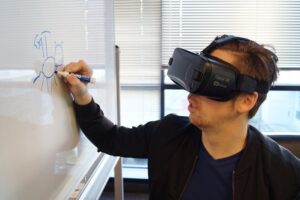Thanks to two wars, a billion-dollar lawsuit against the NFL by its alumni, and the premature brain injury-related deaths of several sports legends, brain injury has leapt from a case of deniability to part of our social conversation. We’ve taken giant leaps in diagnosing and reporting these diagnoses, increasing preventative measures, and finding treatment and therapy programs. On top of that, neuroscience has exploded in the past decade, along with attendant focus on brain disorders such as PTSD, ADD, ADHD, Asperger’s syndrome, Alzheimer’s, dementia, the autism spectrum, TBI, and more.
Now, it’s time to leap into next-generation therapies that restore injured brains to equal or even greater function while refining protocols and technology to determine types, locations, and severity of brain injuries much closer to the time of impact or other event.
“There’s still so much we don’t know about the brain; we probably use 10 to 12 percent of our brain’s potential in a given day,” said Dr. Andre Fredieu, former medical director and current consultant for Cerebrum Health Centers in Dallas. “There’s 90 percent of brain function where we don’t know exactly what is involved. People who have suffered brain injuries might seem to be doing extremely well, and actually operating within that other 90 percent. That can lead to subtle deficiencies that can hamper them when they try to manage their lives and other basic functions. What we don’t know will play a role in what we can ultimately discover in treating the brain.”
Let’s Talk Brain Injury
Cerebrum Health Centers are leading-edge diagnostic and brain rehabilitation facilities. Their combination of diagnostic and therapeutic technology, and therapy protocols that include nutrition, exercise, activities, homeopathic and naturopathic treatments, along with standard medical treatments, has earned them accolades from all corners of the brain injury issue.
“We’re optimizing neuroplasticity — the brain’s ability to heal itself,” says Dr. Brandon Brock, lead clinician for Cerebrum Health Centers in Dallas. “We create an environment for the healing of the brain. That includes use of different types of diagnostic equipment to pinpoint where the issues are in the brain, and using very innovative technology like our patented off-axis rotational chair. We also use particular technologies to optimize eye movements.”
Eye movements are a primary indicator of hidden brain injuries. The binocular vision work of Dr. Patrick Quaid, the author of Seeing is Behaving (to be released in 2016), and his team at the Guelph Vision Therapy Center in Ontario, Canada, has put him on that country’s front line on the subject. In the U.S., Fredieu and his colleagues at Cerebrum Health Centers have further amped up the eye-related brain diagnostics and therapy with videonystagmography (VNG), a machine that tracks eye movement in order to diagnose a specific type of brain injury or disorder.
“Our eyes and our vestibular system receive the most information from the environment and bring the most input into the greatest number of areas of the brain,” Fredieu explained. “If we have a brain injury, our eyes won’t move together well, or move smoothly. Our eyes aren’t moving in a way to allow us to see things correctly — which diminishes the quality of information we receive from the environment and how the brain processes it.”
From the therapeutic side, Cerebrum uses devices including the off-axis vertical rotational chair, which spins in different positions and directions to activate damaged parts of the brain. “We can take results from our diagnostic equipment and put a very specialized treatment plan together with the chair,” explained Dr. Sandeep Vaid, medical director at Cerebrum Health Centers in Atlanta. “If we spin someone to the right, we’re activating their left hemisphere. If we spin them forward, we’re reaching the posterior portion. We can look at how someone’s eyes are moving and deficiencies in their balance, and use the chair.”
Fredieu and other neurologists are quick to point out we’re still at the beginning. Studying the inner workings of the brain is very similar to studying the universe — the more you find, the more awaits discovery. One area always sits at the tip of Fredieu’s tongue.
“We really need to do a better job of identifying brain injury faster,” he said. “If someone suffers a subtle injury, and they’re placed back in the field — whether military theater, the gridiron, or even a classroom setting —if their brain hasn’t been given the opportunity to heal, then further damage can result.”
By Robert Yehling
Senior Writer and I&T Today Founding Editor ROBERT YEHLING is the author of Just Add Water, a biography of autistic surf star Clay Marzo.









